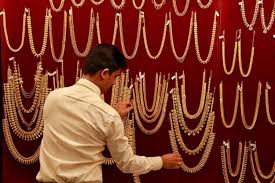Indians may be falling out of love with gold

P.N. GADGIL & SONS, a jewellery shop in Thane, a suburb of Mumbai, is gearing up for the wedding season—a busy time for gold sales, even if demand is brisker still during Hindu festivals, when jewellers stay open almost round the clock. Free samosas and Pepsi are offered to those queuing outside; inside, the noise and bustle are non-stop.
Indians have long regarded gold as the surest store of wealth. Brides bring it as dowry. Newborns are given bangles and anklets. Astrologers prescribe gold rings for stress. Indian households own 23,000 tonnes, three times more than the bullion held by America’s Federal Reserve. In the year to March 2018 gold imports, at $ 74.7bn, ranked after only oil.
The government has tried repeatedly to break Indians’ addiction, increasing import duty fivefold since 2013. In 2015 it began a scheme allowing investors to exchange gold for interest-bearing bonds and get it back when the bonds mature. Television commercials nudge viewers to invest in mutual funds instead.
Such efforts long seemed unavailing, but something seems to have shifted. Demand has fallen by a fifth since 2010.
Consumer preferences are one reason: many prefer lighter jewellery for daily wear. Millennials, a third of the population, spend more than older generations on mobile phones and other electronic goods. The international price of gold has gone up; last month it was near a five-year high, measured in dollars. The weak rupee, close to a record low at 70 to the dollar, makes the domestic price dearer still. A goods-and-services tax introduced in 2017, one-third higher than the levy it replaced, has also hit sales. And with inflation down to just 2.6%, gold’s utility as a hedge has lessened, says Ajit Ranade, an economist.
Jewellers’ margins are already slim, gripes Rajendra Jain, who owns another shop in Thane. Online firms selling small amounts for as little as one (American) cent are adding to the pain. Since 2016 over 30m customers have traded three tonnes via Paytm, an e-commerce giant. The average transaction is 50-100 rupees. It’s like “buying shampoo in small sachets instead of the whole bottle,” says Gaurav Mathur of SafeGold, a rival.
Jewellers, who account for 70% of sales, are also still recovering from the government’s messy recall, in 2016, of high-value banknotes, which squeezed cash purchases. The end of India’s love affair with gold may be overdue. But it is bad luck for the shopkeepers of Thane.

